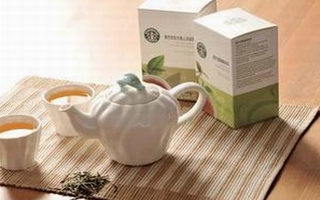 tarbucks Corp. works to integrate Teavana into its portfolio, tea, a small but core part of the Seattle-based company’s business for more than 40 years, should show signs of becoming a meaningful contributor to incremental growth in the years ahead, Troy Alstead, chief financial officer and chief administrative officer for Starbucks, said during a May 22 presentation at the Barclays Americas Select Franchise Conference in London.
tarbucks Corp. works to integrate Teavana into its portfolio, tea, a small but core part of the Seattle-based company’s business for more than 40 years, should show signs of becoming a meaningful contributor to incremental growth in the years ahead, Troy Alstead, chief financial officer and chief administrative officer for Starbucks, said during a May 22 presentation at the Barclays Americas Select Franchise Conference in London.Starbucks acquired Atlanta-based Teavana Holdings, Inc. late last year for $620 million in cash. Teavana is a specialty retailer offering a variety of loose-leaf teas, tea-wares and other tea-related merchandise through 300 company-owned stores and on its web site.
Mr. Alstead said that while tea is the second most consumed beverage in the world, after water, it is only a “tiny, low single-digit share of our overall sales.”
“It has never been a focus of ours, nor have we ever put the kind of energy against it or had the capabilities in tea that we have historically provided with coffee,” he said.
But indications are that it’s time for tea at Starbucks, and Mr. Alstead believes that over the next several years tea will become an incremental driver of revenue and profitability for Starbucks.
Mr. Alstead described the Teavana acquisition as a “threefold proposition” for Starbucks, with two “high” priorities, and another further down the road.
The first priority, he said, is remaking what the typical Teavana store has been.
“The Teavana store … is predominately a mall-based mercantile (with) very little beverage presence at all,” he explained. “(It has been) largely dry tea, (with a) great selection of wonderful teas and merchandise. That is a very effective, great unit economics model. We’ll continue to add Teavana stores in the appropriate locations that are consistent with the previous generation.”
With Starbucks help, though, Mr. Alstead said the company is focused on bringing more beverage innovation.
“It is theater in the store, it is the beverage bar concept,” he said. “And creating a new concept of a tea house — a Teavana-based tea house — that will feel very similar and very familiar to that Teavana customer, but will, we believe, add another layer of revenue and profitability and growth into the Teavana concept, which is by bringing some innovative kinds of tea beverages into that concept.”
Mr. Alstead said the “new generation” of Teavana stores will begin to open up later this year, first in the United States, but ultimately in other markets of the world as well.
A second priority with the Teavana acquisition will be finding a way to make tea a more meaningful part of the experience within a Starbucks store.
“One of the things we have learned from our customer, particularly in recent years as we’ve really tried to dig deeper into understanding our customer, is that the core Starbucks customer who is a coffee drinker is also a tea drinker,” Mr. Alstead said. “Now, I’ll be honest with you, I don’t think we understood that years ago.
They are also a tea drinker, but we didn’t get that tea consumption from them, even if we were getting that coffee consumption, because they never viewed that Starbucks had the quality of tea they wanted or were even aware that we offered tea meaningfully in our stores.
“What Teavana allows us to do is deepen our capability around high-quality sourcing and blending of tea. And again, by bringing together our beverage innovation capabilities in our R.&D. facilities we are developing a whole new platform of tea beverages that we think will be very exciting.”
The final priority, and one that Mr. Alstead acknowledged is further down the road, will be taking tea and Teavana and making them more meaningful in the consumer packaged goods channels.
“Tea down the grocery aisle is a huge category, all forms of tea — ready-to-drink, dried,” he said. “And we have an opportunity with a brand like Teavana, particularly as we build it through the Starbucks platform, to create more awareness, to elevate that brand, to create that proposition, to perhaps bring to bear Starbucks loyalty program, to move our customers and to make them aware that now they can experience tea down the aisle. And we will layer that onto our C.P.G. capability.”
He said the move into C.P.G. channels is “probably two to three years off.”





